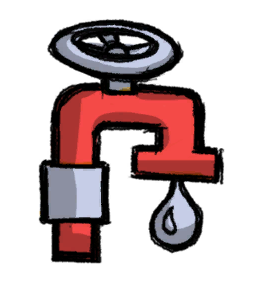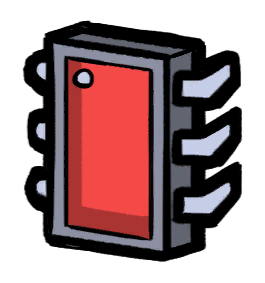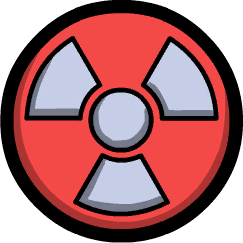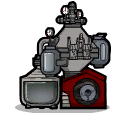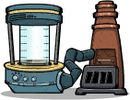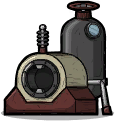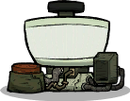Desalinator
Jump to navigation
Jump to search
Desalinator is a building that filters Salt Water or Brine to make water and salt.
- 5 kg/s Salt Water = 4.65 kg/s Water + 350 g/s Salt
- (outputs at the temperature of input)
- 5 kg/s Brine = 3.5 kg/s Water + 1.5 kg/s Salt
- (outputs at the temperature of input)
The Desalinator operates at 100% efficiency, generating as much salt as physical transition.
The Salt is stored inside the Desalinator. Once it reaches 1000 kg, the Desalinator stops working and has to be emptied by Duplicants.
Heat economy
- When processing Brine, the SHC of the output (70% * 4.179 SHC + 30% * 0.7 SHC = 3.1353 SHC) is lower than the input (3.4SHC) by ~8%, resulting in some heat deletion.
- When processing Salt Water, the SHC of the output (93% * 4.179 SHC + 7% * 0.7 SHC = 3.93547 SHC) is lower than the input (4.1 SHC) by ~4%, resulting in a small amount of heat deletion.
Tips
- Input Salt Water / Brine, and especially Brine from a Cool Salt Slush Geyser should be pre-heated to at least 0°C to prevent pipes breaking from freezing output water. A Geotuner is an excellent way to do this, as the Salt produced by desalination can be processed into the Bleach Stone required for the geotuning via a Bleach Stone Hopper. This will also increase the total amount of Brine produced by the geyser.
- It will pass regular water and polluted water without being damaged and without any power cost.
- It requires emptying at approximately 1000kg of accumulated salt. Thus, desalinators processing Brine will require more frequent emptying than ones processing Salt Water, due to the difference in ratio of water to salt produced per second.
- It has a fairly low mass, at 200kg, while producing 8 kDTU/s during operation. This can lead to it overheating fairly easily, especially when constructed with materials with a low SHC, particularly Gold Amalgam, despite it's bonus to overheat temperature. Providing additional thermal mass in the form of Tempshift Plates, submerging it in a layer of liquid, or building it out of a material with a higher SHC, such as Aluminum Ore, can make it considerably easier to keep the building at safe temperatures.
- Boiling salt water or brine into steam and salt by heating it and then condensing the steam into pure water is an alternative way to handle desalination. As this method does not require the Duplicant labor of emptying the desalinator, or it's power requirement, it is a potentially more efficient way to purify water. However, it would also be considerably more complex to build.





